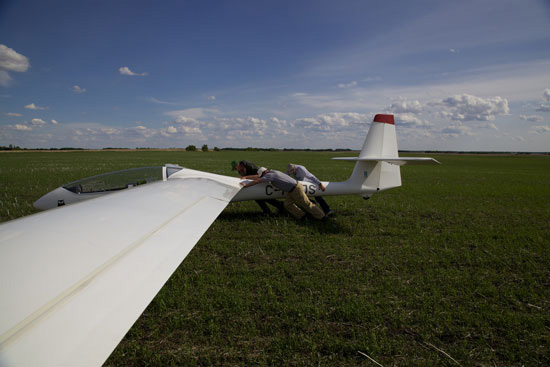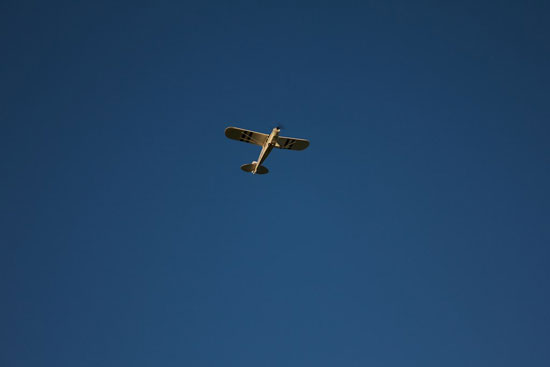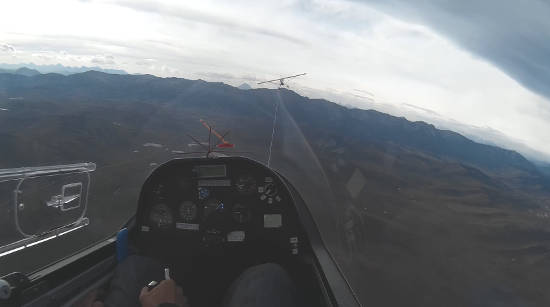Learn To Fly

What are the steps to take?
Learning to fly gliders is something almost anyone can do with a little desire and commitment.
The costs are not prohibitive (see rates for details). You could count on spending about $1500 - $3000 for one season of flying depending on how often you can come out. All the instructors are volunteers so you just pay the rental and tow fees.
To start with, you would be flying in our Blanik L-23 all-metal trainer. You would fly in the front seat while an instructor with years of experience would be in the rear seat. Instructors do not charge for their services. You simply pay for your own rentals and tows.
Your early training flights would involve the instructor doing the take-off, tows, landings, and letting you follow along with your hands and feet on the dual controls. The instructor would then relinquish control to you when it is safe to do so. If you have any problems, the instructor will simply take control of the glider once again.
It probably won't be too long before you start taking control during the critical take-off, tows, and landings yourself.
If you're fortunate, many of your instructional flights will involve soaring. The Blanik trainer actually soars remarkably well. When the conditions allow, your instructor will put you in the middle of a big thermal (column of rising air) and let you fly the glider up to several thousand feet above your tow release point.
Training For Your Pilot License
Introduction

The best way to get a taste for this sport is by taking a familiarization flight. Let your instructor know you are thinking of training to obtain your license and he can give you a detailed explanation of all the facets of glider flight.
Once you commit to the training program, you will start learning on the ground. You need to know what all the controls and instruments do. You need to be able to safely move your aircraft on the ground. Safety in the sport is paramount, so you also need to learn how to perform a walkaround check before each flight as well as the required daily inspection of each plane.
In parallel with your flight training, you will also need to meet several regulatory and club requirements. As bureaucracies tend to move slower than the learning progress of a student, you are advised to arrange for each of these as early as possible in each phase of your training:
- You need to join as a member of the club and maintain a minimum balance on your flying account.
Prior to going solo, you will need to:
- Be at least 14 years old
- Write the club pre-solo written exam
- Write the Industry Canada Restricted Operator Certificate exam
- Meet medical fitness requirements which may require you to complete a medical with a Transport Canada-approved medical examiner
Once you meet the above, and your instructors agree you are ready, you can start flying solo while staying under the supervision of your instructors. Prior to obtaining your license, you will need to:
- Be at least 16 years old
- Obtain a class 4 or higher medical certificate from Transport Canada
- Take the Transport Canada Aviation English Language Proficiency Test
- Attend at least 15 hours of ground school
- Write the Transport Canada GLIDE exam
- Perform a minimum of 20 solo flights with a combined 2 hours of solo flight time
You will take one more flight with the Chief Flight Instructor who will check to see if you've gained sufficient knowledge and skill to pass the flight test. With his recommendation, you can schedule the test. This will consist of multiple flights where you'll demonstrate you can operate gliders in a consistently safe way with sound decision making.
That's just the beginning in what we hope will be your lifelong participation in soaring. From there, you can learn to fly out of gliding distance of the airfield in a discipline called cross country soaring. You can visit various other soaring facilities and get to know your destination from the sky. Maybe you can share the joy with others by becoming an instructor.
Ground School
You can begin your training without taking any classroom time. Before you go up for your first solo, we need to make sure you have basic knowledge of aircraft operations, communications and air law. To verify this you will the approval of your flight instructors, and write a club pre-solo written exam.
You will also need to operate the radio in your glider. During your first few flights, you'll have enough other things to learn, so your instructor will operate the radio for you. By law, you need to obtain certification before you work the radio to ensure your radio communication follows government mandated standards. You will need to learn the standards, published free of charge by Industry Canada, pass a multiple choice test, and pass a practical test. This will grant you an Industry Canada Restricted Operator Certificate - Aeronautical (ROC-A).
To continue your training and get your license, you need to take 15 hours of ground school and pass the Transport Canada GLIDE exam, which is a multiple choice test of your knowledge of the following subject areas:
- Canadian Aviation Regulations
- Aerodynamics and Theory of flight
- Meteorology
- Airframes and Systems
- Flight Instruments
- Navigation
- Flight Operations
- Emergency Procedures
- Human factors including pilot decision-making
ESC offers an annual ground school free of charge, usually in February or March. This satisfies the 15 hours requirement. Once you've completed most of your flight training, our Chief Flight Instructor will recommend you to write the GLIDE exam.
Early Flights
During your first few flights, your instructor will perform the take-off, tow and landing. You can gently hold the stick and follow along, learning the control inputs required for great take-offs and landings. Once you release from the tow plane, you will take control and learn the basics of handling the glider.
First and foremost, you need to often visually scan your surroundings for hazards in the sky. We call it maintaining a good look-out. There's more to it than just looking out the glider canopy. It can be tricky to spot and assess risks to your safety so you'll learn some techniques to make your look-out effective.
You'll learn the effects of the controls. You'll see how rolling into a turn can yaw the aircraft in the opposite direction, and how to counteract that with rudder control to stay aerodynamically efficient in what's called a coordinated turn.
You'll learn to fly straight to a point at a constant speed. Sound easy? You may be surprised when you first try. It's a good chance to learn about the stability characteristics of your aircraft, and how our active atmosphere can affect your plane.
One key soaring skill is to make continuous turns at various bank angles so that you can remain in the center of an upward convective current of air, known as the core of a thermal. All the while you still need to maintain a good look out. You will learn to make elegant turns to suit any situation.
Next Few Steps

As you take more flights, you will gradually take control for a longer part of the flight.
After take-off, the instructor will give you control for the duration of the aero-tow. Hone your flying skills by trying to maintain perfect position behind the tow plane.
You will learn the characteristics of the propeller wash behind the tow plane, and how to switch between high and low position relative to the tow plane.
At high altitude, you will practice using the spoilers, or airbrakes depending on the aircraft, and how they affect lift on your wings.
You will learn to plan a proper landing circuit, and what to do if you are too high, too low, or out of position relative to the airfield. One step at a time, you will plan and execute your final approach. The first time you take control on final, you will manage the stick to control speed while your instructor manages the spoilers to keep your aircraft descending to a pre-planned landing reference point. The next flight, you will swap roles. Finally, you will combine what you learned to execute your first landing as a glider pilot. Congratulations! Soon you will take control for the entire flight and be well on your way to your first solo.
Preparing For Solo Flight

Though you can now handle all phases of flight, there are still some important skills to learn before you can safely fly on your own.
- You need to learn how to recognize an imminent stall, and how to recover from one
- You need to be able to recover from spiral dives and spins, both of which require specific steps to follow in order to resume normal flight
- You need to handle unexpected rope breaks and tow plane emergencies
- You need to be able to sideslip in case your spoilers or airbrakes are inoperable or not effective enough
Once you've demonstrated you can handle normal flight with reasonable finesse as well as these emergencies, and passed the club pre-solo exam, you are ready for your first solo!
Honing Skills
You'll use your new solo flying privileges to improve the skills you've already been introduced to. You can further improve your control on tow by practicing what we call boxing the wake, where you fly your glider around the complete perimeter of the tow plane's propeller wake. You can start fine tuning your ability to stay in thermals, and making crisp, coordinated turns.
In this phase, you will still fly with an instructor at least once every flying day. These flights will be a great chance to practice landing in various situations using advanced techniques like crabbing and slip turns. You'll be able to handle forced downwind landings, crosswind landing, or abbreviated circuits. You will become even more knowledgeable of the characteristics of your aircraft, learning various situations that can lead to stalls and spins.
Sooner or later as your flying takes you further away from Chipman airfield in pursuit of flying goals, you will be forced to land away from the airfield, called landing out. To be prepared for this, you will learn to select the best possible field for a safe landing using various cues.
Once you feel comfortable with the knowledge and skills you've just read about, you can take your flight test and, in conjunction with passing your written test and meeting other regulatory requirements, obtain your Glider Pilot License!
After You're Licensed
Cross Country
As you improve your soaring skills, you'll be to stay airborne for hours. On a good day, you could fly for hundres of kilometres. Flights that take you outside of gliding range back to the airfield are called cross country flights
You could visit a good portion of the province. Flights to the Saskatchewan border, to Drumheller, and to the edge of the boreal forest have all been made from here.
Our club hosts regular cross country training camps for pilots interested in doing cross country soaring. Some of the skills covered are:
- Thermalling Techniques
- Speed to Fly
- Effective Inter-Thermal Flying
- Low Loss Flying
- Final Glides
- Outlandings
- Planning for a Big Flight
- Tephigram Analysis
- SeeYou Flight Analysis
- Safety
Cowley Gliding Camp

Every year, the Alberta Soaring Council operates gliding events near Cowley, Alberta. The summer camp takes place around the August long weekend and the fall camp is around Thanksgiving.
Summer camp participants usually enjoy fair weather and thermalling flights that can extend to much of south-western Alberta. The fall camp tends to have strong winds condusive to mountain wave development over the Livingstone mountain range. This allows for flights exceeding 20,000 feet on a regular basis
For more information, check out the Alberta Soaring Council page on the camps.
Badges and Records
What is the next goal after soloing or getting your pilot license? How do you keep yourself motivated and continue to learn and develop new skills? One option that is available is the FAI Badge program. This is an international proficiency program that is open to all members of the club.
This program has a number of different levels that students and licensed members can work towards. Each level requires the pilot to demonstrate or achieve a specific level of performance and this performance must be documented and observed by an 'official observer' to qualify for the award... so to participate, you need to know the rules and you have to have a plan.
The requirements for each award are outlined in the FAI Sporting Code. The sporting code also covers details on claiming records for various achievements in distance, duration and altitude gains should you strive for beating one.
Here are the basic requirements for the first three badges:
- A badge - Solo flight
- B badge - 30 min soaring flight
- C badge - 1 h flight + 2 h total solo time
The requirements for the Bronze Badge are geared towards getting pilots ready for cross country flights and involves a number of flying and ground exercises.
If you are interested in learning more about the FAI badge program, speak to any of your instructors or the club CFI.
Competitions
From the Soaring Association of Canada Website:
Soaring Competitions, also known as "contests", are one of the most interesting and exciting aspects of soaring. Soaring competitions pit pilots against eachother in a race for distance, where the fastest overall pilot at the end of the competition is the winner.
From local intraclub contests to the world championships, gliding contests exist in many forms. Gliding contests are typically held over several days and can be as long as three weeks for larger national and international contests. During the contest, pilots fly around courses designated by turnpoints set at the beginning of each contest day, which can vary from as little as 100 kilometers to as long as 500 kilometers or more. Pilots fly around the designated course for the day, with the fastest pilot around the course being declared the winner and receiving the highest points for that day. The other pilots are ranked for the day and receive points in accordance with their percentage of the winner's speed. At the conclusion of the contest, the pilot with the highest number of points is declared the winner.
In a sport where one's ability to remain aloft is determined by naturally-occuring updrafts and the pilot's own skills, going fast isn't as simple as just pushing the stick forward and speeding up. The best pilots will maximize their speed by flying as efficiently as possible, finding the best path through the sky to the turnpoints, stopping only to climb in the strongest updrafts. Average speeds for a competition day can vary greatly and depend largely on the weather; however, if it not uncommon to see the winner's average speed in excess of 100 km/h over courses that can range from 300 to 500 kilometers.
There are a number of soaring competitions that occur annually across Canada. The pinnacle of Canadian soaring contests is the Canadian Nationals, held annually at a soaring club in Canada. Pilots from all across Canada unite for ten days of racing, where the winner is crowned the National Champion. Several provinces also hold Provincial and regional contests, which are fun contests to participate in regardless of your experience level.
Besides scheduled competitions, you can also upload digital flight recordings to the Online Contest website at any time. The better your flight, the more points you get, and you can see who collects the most points at the club, in Canada or internationally, for any given day or a given skill level.
